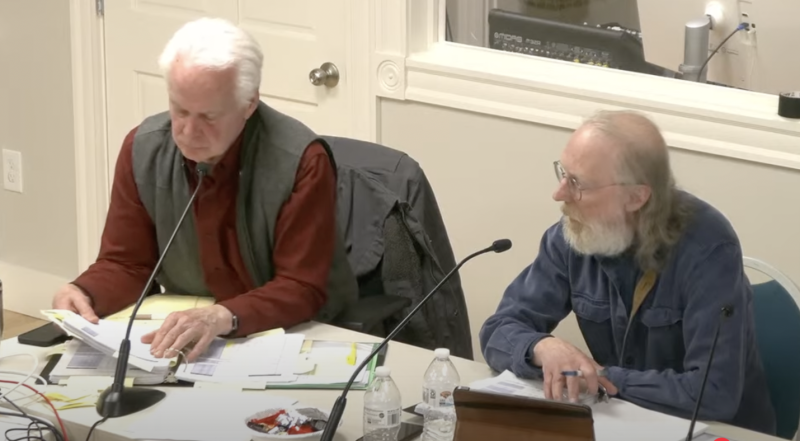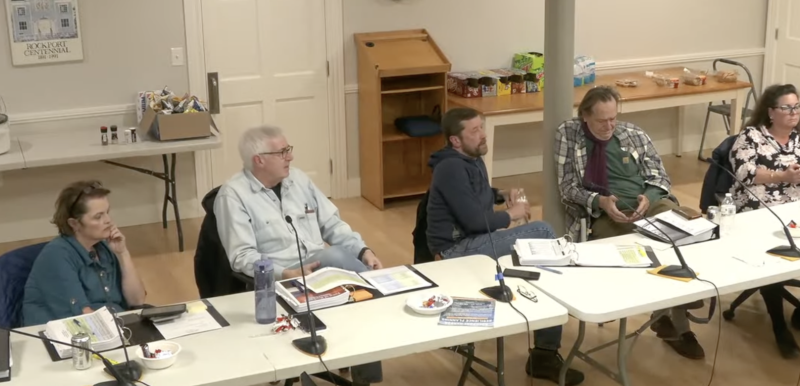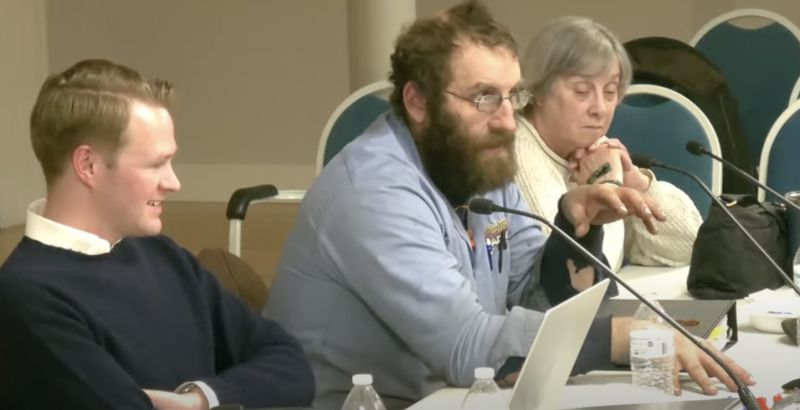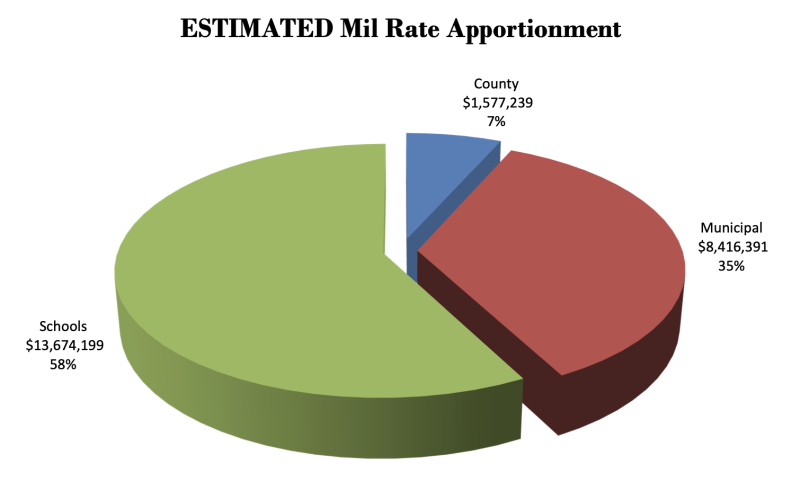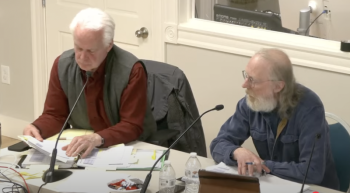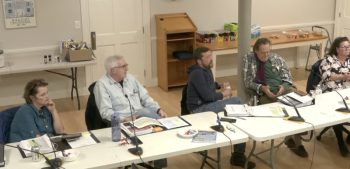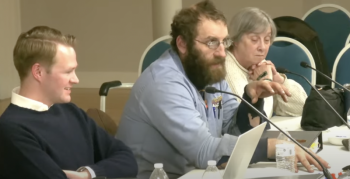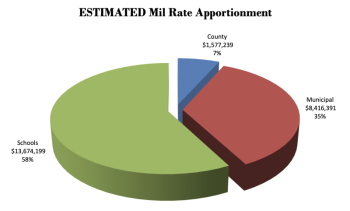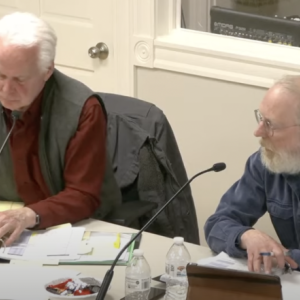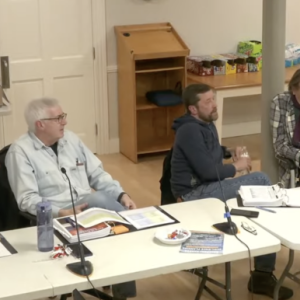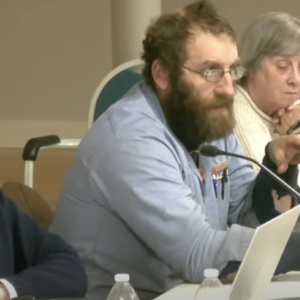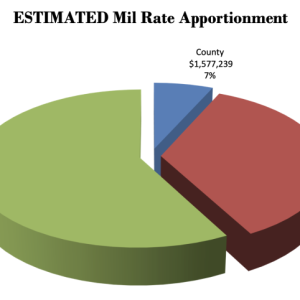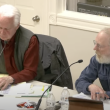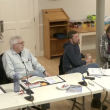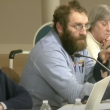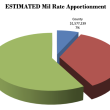Rockport Select Board, Budget Committee reviews and debates proposed $13 million municipal budget
ROCKPORT —The Rockport Select Board and Budget Committee have begun a detailed review of a 2025-2026 $13 million budget for the Town of Rockport, with meetings with department heads underway and deliberations scheduled to take place over the next two weeks (March 31, April 7).
On Monday, March 31, the Budget Committee will convene and produce its recommendations for the Select Board. On April 7, the Select Board will discuss the budget, and consider the Budget Committee recommendations, accepting or rejecting them. Then, the Select Board will vote to put its final budget before voters at Annual Town Meeting, June 10.
All budget meetings are held at the Rockport Opera House downstairs in the Geoffrey C. Parker Meeting Room, and are streamed live.
Municipal budgets are what determine how property taxpayers spend their money, what residents find important, and how they keep their towns functioning. Municipal and school budgets appear before voters at annual Town Meeting on a warrant and considered by secret ballot at the polls. It is up to the voters to decide what they want to spend money on. That results in how much they pay in property taxes each year.
"Process is really, really important," said Town Manager Jon Duke, speaking March 15 to both the board and committee at their first joint meeting. "It will be something a little different from what we had in the past years. In large part, to try and get to a point quicker where decisions are made."
On March 25, at a joint meeting of the Budget Committee and Select Board, Budget Committee member Steve Bowen suggested the process needs refinement for future budget reviews.
"That's the challenge," he said. "I'd like to say that after four meetings over the course of two weeks we could make reaosnable thoughtful recommendations five days from now on a $12 million budget. The process does not lend itself. This is not anything we can fix now, I realize. But, it just doesn't lend it self to systemic level challenges."
Budget Committee Chair Clayton Tolman agreed.
"Realistically, what should happen is that we should staff a budget committee throughout the year," he said. "We should be having more meetings throughout the year, and getting more in depth. Let's look at our Public Works. None of us sitting in this room really know the budget to say, 'you really could cut here.'"
Others agreed that the schedule was too tight to fully understand the details of the budget. One person suggested a task force be created to look at rising health insurance costs. Another person suggested setting Select Board priorities in July that would include a broader approach to shaping the municipal budget.
"What I'm hearing is that big changes, or systemic level changes, are off the table for this budget," said Bowen. "I'm hearing that we should focus our efforts on, 'pave from here to here,' or 'don't this car, don't buy this hammer,' but the bigger stuff, 'don't bother wasting your time.'"
Budget Committee member Walker Angell said it would be possible to find less costly health insurance plans, and switch when open enrollment rolls around.
"The health insurance costs seem astronomical to me," he said.
At the March 25 meeting, a conversation ensued about how to reduce meaningful budget costs.
"The most important role is what gets communicated to voters," said Bowen. "[When] they can go inside to see the ballot, I want them to see some flashing yellow lights. Because we have substantial budget challenges. The budget grew by double digit percentages four years in a row. It used to go up 5 or 4 percent a year. It is now 11 or 16 percent. The town has to better understand that. The discussion I would like to have on Monday is how do we signal to the town that this is the plane we are on."
Select Board Chair Denise Munger responded: "Is the goal to have the voters reject the budget?"
Tolman suggest the goal of the Budget Committee is to make recommendations for the budget and suggest more substantial changes outside of the budget process to the Select Board.
The conversation returned to the topic of health insurance, which, again, Angell said, "is probably one of the least impactful ways to save meaningful money."
Rockport employees get their health insurance as part of an insurance pool managed by the Maine Municipal Association.
Rockport taxpayers currently face a budget pie that represents increased expenditures across the board, from county to school to municipal appropriations.
They are:
Knox County budget increase of 13.9 percent. That budget is $14 million, up from the current $12.6 million budget. Rockport's share of that budget will be $1.7 million. Last year, Rockport's share was $1.5 million. Rockport taxpayers are expected to shoulder an increase of $192,861 to help fund the county this coming year.
SAD 28 and Five Town CSD (Camden Hills Regional High School) budgets together are expected to increase by 8 percent; however the two districts are still working on their budgets.
As of March 14, Superintendent Maria Libby reported to the SAD 28 Board of Directors: "While there are always unknowns and moving parts during the budget development process, preparation has been especially difficult this year because there is even more uncertainty about costs. We have been notified that our health insurance is going to increase even more than initially expected, but will not know the exact amount until early April. I am also concerned about the rapidly rising cost of construction/repairs/maintenance. I will present the current known changes to the budget to the board at this meeting, before presenting the final budget at the April meeting for Board vote."
Rockport municipal budget is to increase by 13.89 percent to $13 million, up $1,026,542 from the current budget.
The budget review process
The goal is to get questions addressed earlier in the review process, and Town Manager Duke urged the board and committee to maintain momentum.
"There are so many different lines and pieces of this budget, and I understand and appreciate the desire to go as slow as you can," he said. "The challenge is, this is a ball that is moving at incredible speed whether we want it to or not. And it will come to land on a Select Board agenda on April 14."
Duke outlined Rockport's fiscal history over the last year, and decisions and circumstances that have shaped the proposed budget.
He noted in his introduction to the 2025-2026 budget as posted at the town website: "In short, this budget is the vessel that completes many projects and policies begun over the last several years that while the ideas are not new, the final costs’ inclusion in the annual budget adds to the bottom line."
In his March 15 presentation to the board and committee, Duke said the West Rockport Fire Station is the biggest project — "We are 98.75 percent complete," said Duke. "We are inhabiting the building, using the building. There are some key pieces that still need to work better, like the garage doors. They work, but some buttons don't and some do."
That process has taken far too long, but the product at the end is good, he said, updating the board and committee about the town's commitment to establish its own EMS service at the West Rockport Fire Station.
Duke also described the repair of Robinson Drive, where the subdivision road intersects with Route 90 in West Rockport. That road collapsed at the intersection over a brook at the end of October 2021. Since then, the town has attempted to get financial relief for the $700,000 repair from FEMA, but to no avail. Costs associated with the rebuild are more like $1.5 million, said Rockport Finance Director Megan Brackett, after adding in interest rates, town staff wages and benefits, overtime, administrative time in pursuing federal grant money for the storm recovery, and emergency public works response the day that the culvert washed away.
The town paid for the repairs through its unassigned fund balance. That account represents funds not earmarked for any specific purpose and used at the discretion of the Select Board, equal to at least 12% to 15% of the total annual budget comprising the proposed operating budget to be voted on at Town Meeting, the County Assessment, the School Assessment, the annual TIF payment and the estimated Overlay.
"Working with FEMA," over the last 3.5 years has been frustrating, said Duke.
"It is a failure of the federal government," he said.
"It's all been approved," asked Select Board Chair Denise Munger.
"Yes," said Duke.
Upcoming challenges
Before outlining the proposed budget, Duke said Rockport faces fiscal challenges. He expanded on those in the Municipal Budget overview. They include:
1) Road construction needs: "When you look at the proposed paving plan for fiscal year ending 2026 our goal is to pave 31,727 feet of roadway, which accounts for less than 10% of our 72 miles of Town roads," wrote Duke. "In order to stay on a 10-year replacement schedule, our target is 38,016 feet of roadway, so with this plan we are well short of where we should be in terms of total feet paved."
2) Water crossing projects: "In November 2024, voters approved a bond for $3.4 million which allows the Town to upgrade and improve eight water crossings across town to avoid a sequel to what occurred on Robinson Drive," wrote Duke. "We met with Gartley and Dorsky to initiate the construction on the crossings we hope to complete in 2025. Those meetings have caused us to reorganize our road plan for FY 2025, and then I reorganized the plan once again once it was apparent cuts were needed to reduce the overall cost in the budget. Road construction is one area very vulnerable to the impact of tariffs and the global oil market and we’ve expected a 10% increase in our paving costs for FY 26 but that may not be enough."
3) Intersection improvements: "The intersection at Porter Street and South Street has been problematic for decades but a head-on collision at that location last fall has driven a stronger desire to “T up” the intersection and dramatically improve safety," wrote Duke. "For as challenging as that intersection is, the Route 1/South Street intersection is another frequent accident location and with expected Maine DOT paving of that section of Route 1 this summer, exploration of that area is long overdue."
4) General Assistance: "LD 1732 was passed last session which amends how municipalities provide services to those that need them," wrote Duke. "This requires municipalities to provide trauma-informed services as well as culturally and linguistically services that are designed to serve culturally diverse populations. This also is changing the terms for which we provide assistance. Historically municipalities have provided assistance for 30 days, we will now be required to provide assistance for a maximum of 12 months. These changes are required to be in effect by January 2026.
5) FEMA: "The final remaining projects for this storm are our reimbursements for Robinson Drive, and then reimbursements for staff time." wrote Duke. "They allow you to claim up to 5% of the total awarded for damages as staff reimbursement. We can without a doubt say that this 5% will not even cover the time our Finance Director has spent trying to get this reimbursement, let alone the time spent by our Public Works Department, or Town Manager. To add to this we had another declared event in January of 2024, we have received reimbursement for most of the work that was completed to fix damages from this storm, there is one project outstanding, which is part of the larger waterfront project that we are taking on at the Harbor."
6) School infrastructure needs.
7) Building assessments: town office, public safety building, Opera House, public works: "Space and building needs assessments – in the current FY 25 operating budget we put in money to do space and building needs assessments for the Public Safety Building, Town Office Building and Opera House," wrote Duke. "The needs of each of those buildings are varied but the costs could be substantial so we must be wise in our planning and foresight of each situation. We are working with an architectural firm to complete these assessments and provide recommendations for needed repairs, and ways to increase space. We have identified issues or concerns at each location, and they will be working through their recommendations with hopes to have formal recommendations to us the summer of 2025.
Public Works: "The current building is sinking into the ground and really does not provide the space that we are requiring from it. We have been able to build rest quarters for our staff for those longer storm events in the current building, but this is far from a suitable solution.
"We don’t have enough bays for our front-line trucks to be parked inside during rest time for our staff, so they are having to de-ice their equipment before returning to work. The parking lot is in shambles, but we can’t really address that until we address the issue of the building sinking into the ground. We also need to somehow create a place for our buildings and grounds crew to work from whether it is at Public Works or another location. They need to have space to work on projects that they are completing, and they currently don’t have that.
8) Police retirement: "The Police Chief requested to add another Patrol Office position to help us be prepared to fill these vacancies when they happen, however, I have removed this request from the budget in order to get the overall increase down," wrote Duke. "I do believe that this is a position that we should give consideration to allow for some overlap in shift coverage and minimize the potential of yet another crisis circumstance as we experienced this last fall.
9) EMS: "We also need to consider what regional fire and EMS may look like and how that may transform what we are doing," wrote Duke. "We have been working closely with Rockland as we have embarked on our EMS journey and gained great support from Waldoboro and Belfast as well. Following our approval for a transporting license, I reached out to colleagues in Camden, Hope, and Lincolnville with the offer to meet and discuss how we might further our collaboration, but thus far no communities have taken us up on this discussion. I do believe we are still in the very early stages of our service so ensuring we are not overpromising for the service we can provide is critical... particularly for Rockport taxpayers.:
10) Global economy/federal government role: "All of these are clearly up for debate on how they will be handled by the current administration. All of these could certainly have an impact on how much it costs us to provide the services that we are currently providing. Maine Municipal Association has taken on the duty of trying to follow the bouncing ball that is where Federal actions are moving on these issues."
Key budget increases
On March 15, Duke ran down the list of the budget increases, noting their influencing factors.
They include a 2.5 percent cost of living increase for non-union employees and police department personnel, and a 3 percent COLA increase for public works union employees. Rockport's personnel line in its proposed budget is $4.1 million, and employee benefits are $2.4 million. By comparison, in 2021-2022, those numbers were $1.9 million and $881,910, respectively.
Salary increases for employees who have reached milestones outlined in the personnel policy, up $205,646.
Incorporation of a new Maine Paid Family Medical Leave tax. That tax
A 10 percent increase in health insurance rates.
"That obviously has a signficant impact," said Duke. "Given that a lot of our costs are personnel."
General insurance. The town has to add malpractice insurance to cover EMS service. There have also been claims, in particular with the Opera House, "that have driven some high insurance rate increases," he said.
General assistance increases due to state mandates for additional services.
Police, cruiser and cameras, and body cameras: "About halfway through this fiscal year the Select Board approved a $4 an hour pay increase for all employees and positions in this department, that was not budgeted for in the current year but was covered by having so many vacancies," wrote Duke, in his budget introduction. "However, we are now fully staffed and any increases applied to wages in this department had to start at the increased rate, so it is kind of like a double whammy as we have the mid-year increase and then the normal contracted increases, this combined change equates to $120,270 or 46% of the department’s increase. With increased wages comes increased taxes and benefits expenses, so that is another $87,566. The combined wage and benefit increase is $207,836 or 79%."
Purchase of cruisers and body cameras: $23,356 for this fiscal year, and then will be reduced to $9,156 for the following four fiscal years.
The total budget increase for the police department is up 23 percent from $1.1 million to $1.4 million.
Call increase with the fire department results in volunteer pay: Proposed increase of 21.69% or $119,844. Adjustments were made to the volunteer firefighter annual pay due to increased call volume, and more hours worked by paid volunteers. "There are additional operational expense increases, because the cost of doing business, or having work performed has increased," wrote Duke. "We also have turnout gear and SCBA equipment that needs to be replaced, with a combined impact of $34,000.
Total increase for the fire department is 16.3 percent from $763,529 to $856,372.
Full year wages and benefits for EMS personnel: The EMS department has a proposed increase of 7.75% or $61,865. There is an increase of $250,865 in wages and benefits in this department, "that is due to the fact that we did not budget for an entire year in the current operating budget for wages and benefits, we only budgeted for nine months, so we have to make up three months’ worth of wages and benefits and then any step increases on top of that," wrote Duke. "This is partially offset by the fact that we won’t need to pay our prior provider contract, which is a savings of $127,000, so the net increase is $123,865. We also made some adjustments to revenues, as we don’t really have anything to base our revenue collections on."
The total budgeted amount for the town's new EMS service is $1.34 million.
Increases in utility costs of electricity, internet and water.
Repairs to basketball courts at Marge Jones Fields. The recreation line in the budget has increased 60 percent, from $71,080 to $113,727.
Building maintenance. New budget for new West Rockport Fire Station.
Long term debt: The long term debt line is $629,195 for 2025.
This accounts for the first principal payment for the new fire station: "Long term debt is up 23.65% or $120,345, this upcoming fiscal year will be our first principal payment for the West Rockport Fire Station, which is $91,956, and the interest payment on this bond will also slightly increase, but in preceding years will decrease each year," wrote Duke. "We have also budgeted for an interest only payment on the VPI bond issues that I discussed earlier [$5,000 for counsel to help bonding for the cross culverts bond that was passed in November, and then another proposed bond issue for other infrastructure needs.] and includes an increase on the interest for the bond anticipation note for the infrastructure bond that I also discussed earlier in relations to the two intersections and drainage work."
Public Works is proposing a budget increase of 9.97% or $281,447, primarily attributed to paving and road construction.
It is Town Manager Duke's assessment that Rockport has to contend with considerable issues.
"The challenges our community faces in the coming years are significant and delay current needs for the future is a path tried by leaders in Rockport and it has left us in a less than desirable position," he wrote. "The best we can do for our residents is to tackle these issues head on, with honesty and truth, and work together to get the best result possible.
"Anyone can put their head in the sand and ignore what we face, but leadership and the responsibility which comes with those leadership roles do not provide us the any other option.
"As our community’s relative aging causes a greater need for services and with fewer working age residents able to the cost of living in Rockport, we need better solutions for our future than status quo. Reducing wastewater costs, investing in infrastructure to support workforce housing, and supporting policies which bring down the cost of housing are absolute necessities if we want the Rockport, we live in today to resemble itself in 2045.
"While the high cost of this budget is hard to stomach, backing away from the future and pushing costs for another day will make that future look even harder to accept, let alone afford."

